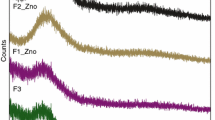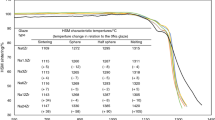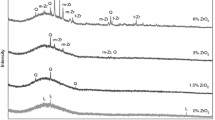Abstract
Thermal properties of raw aluminosilicate ceramic glazes in the multicomponent system of SiO2–Al2O3–CaO–K2O–Na2O–ZnO modified by ZnO addition were studied by differential thermal analysis (DTA), dilatometry (DIL), hot-stage microscopy (HSM), X-ray diffraction and fourier transform infrared spectroscopy (FTIR). Using the method of differential thermal analysis, the ways in which zinc oxides affect the temperature of transition (T g), crystallisation (T c) were determined. An analysis of the DTA data obtained during thermal tests showed that an increase in ZnO content results in decreasing the T g value. Also, the influence of ZnO on characteristic temperatures and viscosity of glazes was checked. The introduction of zinc oxide (ZnO) into the glaze composition contributes to the decrease in viscosity of such glazes. An increasing ZnO content in the glazes also causes the reduction in softening (T s), half-sphere (T half-sphere) and fusion (T fusion) temperatures. The mid-infrared spectroscopy showed that the thermal properties of glazes in SiO2–Al2O3–CaO–K2O–Na2O–ZnO system modified by addition of ZnO can be associated with the depolymerising influence of zinc ions on the structure of the tested glazes.









Similar content being viewed by others
References
Taylor JR, Bull AC. Ceramic glaze technology. Oxford: Pergamon Press; 1986.
Eppler RA, Eppler DR. Glazes and glass coatings. Westerville: Journal of the American Ceramic Society; 2000.
Froberg L, Kronberg T, Hupa L, Hupa M. Influence of firing parameters on phase composition of raw glazes. J Eur Ceram Soc. 2007;27:1671–5.
Ozturk ZB, Yıldız B. The effect of different fluxes on thermal behaviour of floor tile glazes. Acta Phys Pol A. 2015;127:1183–5.
Shelby JE. Introduction to glass science and technology. Cambrigde: Athenaeum Press Ltd.; 1997.
Doremus RH. Glass science. New York: Wiley; 1994.
Lewis MH. Glasses and glass ceramics. New York: Chapman and Hall; 1989.
Handke M, Mozgawa W. Vibrational spectroscopy of the amorphous silicates. Vibra Spectro. 1993;5:75–84.
Gibbs JH, Dimarzio EA. Nature of the glass transition and the glassy state. J Chem Phys. 1958;28:373–83.
Handke M, Mozgawa W, Nocuń N. Specific features of the IR spectra of silicate glasses. J Mol Struct. 1994;325:129–36.
Stoch L. Polish ceramic bulletin 5. Ceramics. 1993;42:21.
Labet V, Colomban P. Vibrational properties of silicates: a cluster model able to reproduce the effect of SiO4 polymerization on Raman intensities. J Non-Cryst Solids. 2013;370:10–7.
Jamaludin AR, Kasim SR, Ahmad ZA. The effect of CaCO3 addition on the crystallization behavior of ZnO crystal glaze fired at different gloss firing and crystallization temperature. Sci Sin. 2010;42:345–55.
Avramow I. Viscosity in disordered media. J Non-Cryst Solids. 2015;351:3163–73.
Avramow I. Interrelation between the parameters of equations of viscous flow and chemical composition of glass forming melts. J Non-Crys Solids. 2011;357:391–6.
Mauro J, Yue Y, Ellison A, Gupta P, Allan D. Viscosity of glass-forming liquids. Proc Natl Acad Sci USA. 2009;106:19780–4.
Avramow I. Dependence of the parameters of equations of viscous flow on chemical composition of silicate melts. J Non-Crys Solids. 2011;357:3841–6.
Isard JO. The mixed alkali effect in glass. J Non-Cryst Solids. 1969;1:235–61.
Day DE. Mixed alkali glasses—their properties and uses. J Non-Cryst Solids. 1976;21:343–72.
Poole JP, Gensamer M. Systematic study of effect of oxide constituents on viscosity of silicate glasses at annealing temperatures. J Am Ceram Soc. 1949;32:220–9.
Poole JP. Low-temperature viscosity of alkali silicate glasses. J Am Ceram Soc. 1949;32:230–3.
Avramov I, Rüssel C, Keding R. Effect of chemical composition on viscosity of oxide glasses. J Non-Cryst Solids. 2003;324:29–35.
Lyon KC. Prediction of the Viscosities of Soda-Lime Silica Glasses. J Res Natl Bur Stand. 1974;78A:497–504.
Berg G, Ludwig A. Mixed oxide effect in an ion-exchanged glass. J Non-Cryst Solids. 1994;170:109–11.
Tomandl G, Schaeffer HA. The mixed-alkali effect—a permanent challenge. J Non-Cryst Solids. 1985;73:179–96.
Kim S-K, Hwang J. Influence of BaO/(SrO + BaO) on some thermal properties of R2O–RO–SiO2 glasses for plasma display panel substrate. Glass Sci Tech. 1999;72:393–7.
Lapp JC, Shelby JE. The mixed alkali effect in sodium and potassium galliosilicate glasses I. Glass transformation temperatures. J Non-Cryst Solids. 1986;84:463–7.
Lapp JC, Shelby JE. The mixed alkali effect in sodium and potassium galliosilicate glasses II. DC electrical conductivity. J Non-Cryst Solids. 1986;86:350–60.
Kim S-K, Lee S-M. Viscosity behavior and mixed alkali effect of alkali aluminosilicate glass melts. J Ceram Soc Japan. 1997;105:827–32.
Beam JK. Effect of opacifiers on fused viscosity of feldspathic glazes. J Am Ceram Soc. 1943;26:205–12.
Lee S-M, Kim S-K, Kim H-T. Crystallization behavior and mechanical properties of porcelain bodies containing zinc oxide additions. J Eur Ceram Soc. 2005;25:1829–34.
Tulyaganov DU, Agathopoulos S, Fernandes HR, Ferreira JMF. The influence of incorporation of ZnO-containing glazes on the properties of hard porcelains. J Eur Ceram Soc. 2007;27:1665–70.
Atkinson I, Angheln EM, Munteanu C, Voicescu M, Zaharescu M. ZrO2 influence on structure and properties of some alkali lime zinc aluminosilicate glass ceramics. Ceram Int. 2014;40:7337–44.
Pekkan K. The thermal and microstructural behavior of a R2O–RO–(ZnO)–Al2O3–(TiO2)–SiO2 based macro-crystalline raw glaze system. Ceram Int. 2015;41:7881–9.
Demirkesen E, Maytalman E. Effect of Al2O3 additions on the crystallization behaviour and bending strength of a Li2O–ZnO–SiO2 glass-ceramic. Ceram Int. 2011;27:99–104.
Sułowska J, Wacławska I, Szumera M. Comparative study of zinc addition effect on thermal properties of silicate and phosphate glasses. J Therm Anal Calorim: DOI; 2016. doi:10.1007/s10973-015-5044-8.
Leśniak M, Partyka J, Sitarz M. Impact of ZnO on the structure of aluminosilicate glazes. J Mol Struct. 2016;1126:251–8.
Yekta B, Alizadeh P, Rezazadeh L. Synthesis of glass-ceramic glazes in the ZnO–Al2O3–SiO2–ZrO2 system. J Eur Ceram Soc. 2007;27:2311–5.
Rudkovskaya NV, Mikhailenko NY. Decorative zinc-containing crystalline glazes for ornamental ceramics. Glass Ceram. 2001;58:387–90.
Parmelee CW. Ceramic glazes. Boston: Publishing Company. Boston; 1973. p. 544–5.
Beall GH, Pinckney LR. Nanophase glass-ceramics. J Am Ceram Soc. 1999;82:5–16.
Fredericci C, Yoshimura HN, Molisani AL, Pinto MM, Cesar PF. Effect of temperature and heating rate on the sintering of leucite-based dental porcelains. Ceram Int. 2011;37:1073–8.
He F, Zheng Y, Xie J. Preparation and Properties of CaO-Al2O3-SiO2 glass-ceramics by sintered frits particle from mining wastes. Sci Sin. 2014;46:353–63.
Lago DC, Prado MO. Dehydroxilation and crystallization of glasses: a DTA study. J Non-Cryst Solids. 2013;381:12–6.
Cabral AA, Fredericci C Jr, Zanotto ED. A test of the Hruby parameter to estimate glass-forming ability. J Non-Crys Solids. 1997;219:182–6.
Avramov I, Zanotto ED, Prado MO. Glass-forming ability versus stability of silicate glasses. II. Theoretical demonstration. J Non-Crys Solids. 2003;320:9–20.
Achmed M, Earl DA. Characterizing glaze-melting behaviour via HSM. Am Ceram Soc Bull. 2002;81:47–51.
Salem SH, Jazayeri SH, Bondioli F, Allahverdi A, Shirvani M. Characterizing thermal behavior of ceramic glaze containing nano-sized cobalt-aluminate pigment by hot stage microscopy. Thermochim Acta A. 2011;521:191–6.
Brekhovskikh SM, Tyul’nin VA, Mamedov ÉK, Shalunenko NI. Spectroscopic investigation of structure and local radiational centers of glasses of the system Al2O3–SiO2. J App Spectrosc. 1977;26:651–4.
Sitarz M. The structure of simple silicate glasses in the light of Middle Infrared spectroscopy studies. J Non-Cryst Solids. 2011;357:1603–8.
Partyka J, Sitarz M, Leśniak M, Gasek K, Jeleń P. The effect of SiO2/Al2O3 ratio on the structure and microstructure of the glazes from SiO2–Al2O3–CaO–MgO–Na2O–K2O system. Spectrochim Acta A. 2015;134:621–30.
Sitarz M, Handke M, Mozgawa W. Identification of silicooxygen rings in SiO2 based on IR spectra. Spectrochim Acta A. 2000;56:1819.
Sitarz M, Handke M, Mozgawa W. Rings in the structure of silicate glasses. J Mol Struct. 1999;511–512:281–5.
Mozgawa W, Sitarz M. Vibrational spectra of aluminosilicate ring structures. J Mol Struct. 2002;614:273–9.
Sitarz M, Handke M, Mozgawa W, Galuskin E, Galuskina IO. The non-ring cations influence on silicooxygen rings vibrations. J Mol Struct. 2000;555:357–62.
Sitarz M, Mozgawa W, Handke M. Vibrational spectra of complex ring silicate anions—method of recognition. J Mol Struct. 1997;404:193.
Acknowledgements
This work was supported by the National Science Centre, Poland, Grant No. 2015/19/N/ST8/00486.
Author information
Authors and Affiliations
Corresponding author
Rights and permissions
About this article
Cite this article
Leśniak, M., Gajek, M., Partyka, J. et al. Thermal characterisation of raw aluminosilicate glazes in SiO2–Al2O3–CaO–K2O–Na2O–ZnO system with variable content of ZnO. J Therm Anal Calorim 128, 1343–1351 (2017). https://doi.org/10.1007/s10973-016-6085-3
Received:
Accepted:
Published:
Issue Date:
DOI: https://doi.org/10.1007/s10973-016-6085-3




